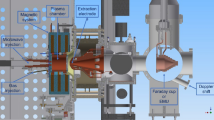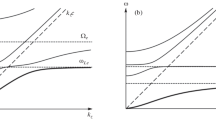Abstract.
Ion sources have a significant number of applications in accelerator facilities and in industrial applications. In particular, the electron cyclotron resonance ion sources (ECRIS) are nowadays the most effective devices that can feed particle accelerators in a continuous and reliable way, providing high current beams of low and medium charge state ions and lower, but still remarkable, beam current for highly charged ions. In recent years several experiments have shown that the current, the charge states and even the beam shape change by slightly varying the microwave frequency (the so-called frequency tuning effect – FTE). The theoretical explanation of these results is based on the difference in the electromagnetic field pattern over the resonance surface, i.e. that region where the electrons resonantly interact with the incoming wave. In order to be consistent with the experiments, this model requires that standing waves are formed also in presence of a dense plasma. The proof was sought by means of a series of measurements performed with a network analyzer and with a plasma reactor operating at 2.45 GHz, according to the principles of the microwave discharge ion sources (MDIS). The measurements have been carried out with the aim to achieve the electromagnetic characterization of the plasma chamber in terms of possible excited resonant modes with and without plasma, and they reported that resonant modes are excited inside the cavity even in presence of a dense plasma. It was observed that the plasma dynamics strongly depends on the structure of the standing waves that are generated. The measurement of the eigen-frequencies' shifts were carried out for several values of pressure and RF power, thus linking the shift with the plasma density measured by a Langmuir probe. The changes in plasma shape, density and electron temperature have been also monitored for different operating conditions. A strong variation of plasma properties has been observed as a consequence of the introduction of the Langmuir probe inside the resonant cavity, thus demonstrating that the standing wave can be strongly perturbed even by means of relatively small metallic electrodes. The measurements reported hereinafter are relevant also for ECRIS, because they confirm the validity of the theoretical model that describes the frequency tuning.
Similar content being viewed by others
References
L. Celona, G. Ciavola, F. Consoli, S. Gammino, F. Maimone, P. Spaedtke, K. Tinschert, R. Lang, J. Mader, J. Rosbach, S. Barbarino, R.S. Catalano, D. Mascali, Rev. Sci. Instrum. 79, 023305 (2008)
R. Geller, F. Bourg, P. Briand, J. Debernardi, M. Delaunay, B. Jacquot, P. Ludwig, R. Pauthenet, M. Pontonnier, P. Sortais, The Grenoble ECRIS status 1987 and proposal for ECRIS scaling, in Proc. 8th Int. Workshop ECR Ion Sources, East Lansing, NSCL report MSUCP-47 (1987), Vol. 1, p. 22
S. Gammino, G. Ciavola, L. Celona, D. Mascali, F. Maimone, IEEE Trans. Plasma Sci. 36, 1552 (2008)
F. Maimone, D. Mascali, F. Consoli, S. Barbarino, L. Celona, G. Ciavola, S. Gammino, Simulations and Measurements About the Electromagnetic Properties for the Cylindrical Cavity of the SERSE Ion Source, INFN/TC 06/07 (2006)
L. Celona, F. Consoli, S. Barbarino, G. Ciavola, S. Gammino, F. Maimone, D. Mascali, L. Tumino, High Energy Phys. Nucl. Phys. 31, 147 (2007)
F. Consoli, L. Celona, G. Ciavola, S. Gammino, F. Maimone, S. Barbarino, R.S. Catalano, D. Mascali, Rev. Sci. Instrum. 79, 02A308 (2008)
S. Gammino, G. Ciavola, L. Celona, S. Passarello, L. Ando, F. Consoli, D. Mascali, F. Maimone, Czech J. Phys. 56, 223 (2006)
S. Gammino, D. Mascali, L. Celona, G. Ciavola, F. Maimone, S. Barbarino, N. Gambino, R. Miracoli, F. Samperi, Diagnostics and preliminary operations of a microwave discharge plasma reactor for complex molecules dissociation, Proc. of 34th EPS Conference on Plasma Physics (Warsaw, July 2007)
D. Mascali, N. Gambino, R. Miracoli, S. Barbarino, S. Gammino, L. Torrisi, F. Maimone, L. Tumino, Radiat. Eff. Defects Solids 163, 471 (2008)
Hiden ESPion-Advanced Langmuir Probe for Plasma Diagnostics, http://www.hidenanalytical.com/, accessed in September 2010
B. Agdur, B. Enander, J. Appl. Phys. 33, 575 (1962)
S.J. Buchsbaum, S.C. Brown, Phys. Rev. 106, 196 (1957)
J. Asmussen, R. Malhtvarpu, J.R. Hamann, C. Park, Proc. IEEE 62, 109 (1974)
J.L. Shohet, A.J. Hatch, J. Appl. Phys. 41, 2610 (1970)
D. Mascali, Ph.D. thesis, University of Catania, 2009
D.M. Pozar, Microwave Engineering (Wiley, New York, 1998)
F. Consoli, S. Barbarino, L. Celona, G. Ciavola, S. Gammino, D. Mascali, Radiat. Eff. Defects Solids 160, 467 (2005)
S. Gammino, J. Sijbring, A.G. Drentje, Rev. Sci. Instrum. 63, 2872 (1992)
Author information
Authors and Affiliations
Corresponding author
Rights and permissions
About this article
Cite this article
Celona, L., Gammino, S., Maimone, F. et al. Observations of resonant modes formation in microwave generated magnetized plasmas. Eur. Phys. J. D 61, 107–115 (2011). https://doi.org/10.1140/epjd/e2010-00244-y
Received:
Revised:
Published:
Issue Date:
DOI: https://doi.org/10.1140/epjd/e2010-00244-y




